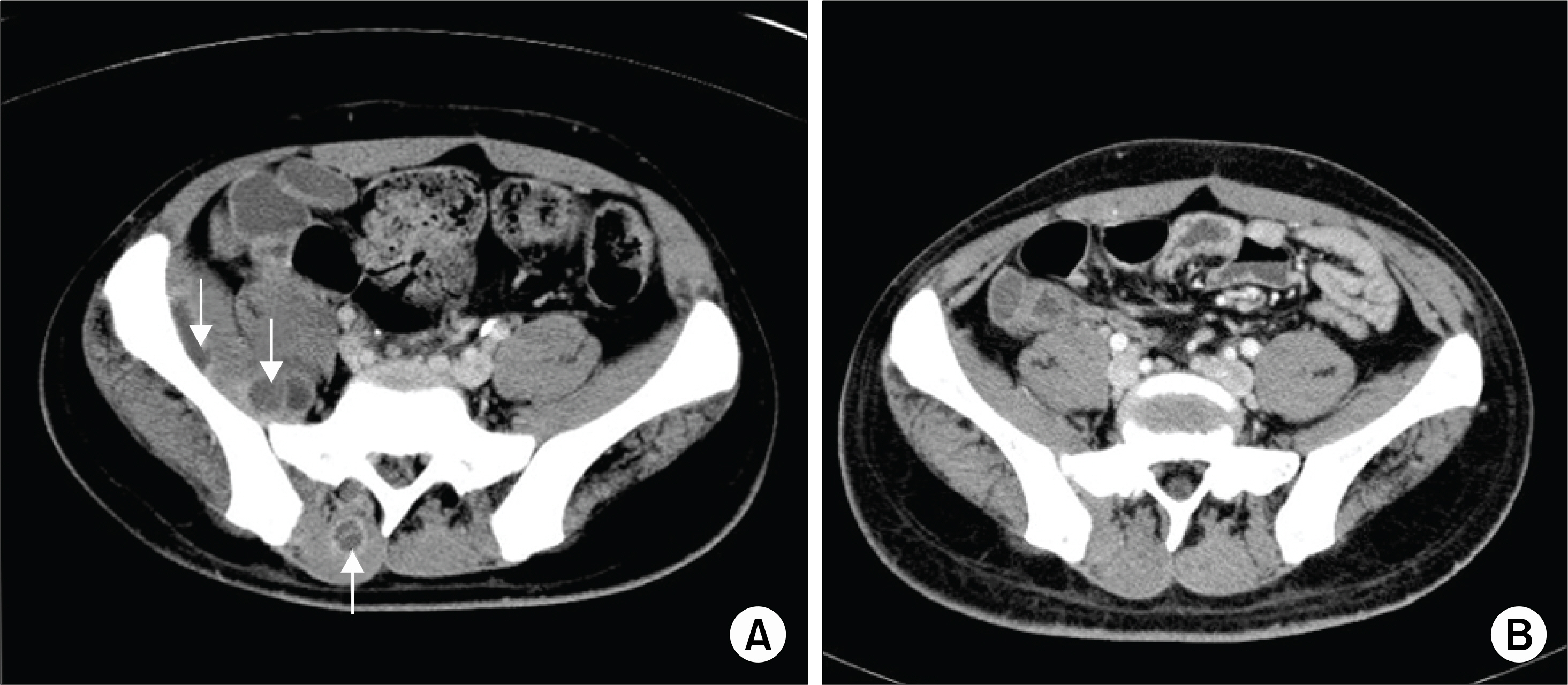J Korean Rheum Assoc.
2007 Jun;14(2):149-153. 10.4078/jkra.2007.14.2.149.
A Case of Septic Arthritis in Patient with Wiskott-Aldrich Syndrome
- Affiliations
-
- 1Department of Rheumatology, Dong-San Hospitlal, Keimyung UniversitySchool of Medicine, Daegu, Korea.
- KMID: 1526432
- DOI: http://doi.org/10.4078/jkra.2007.14.2.149
Abstract
- The Wiskott-Aldrich syndrome is a rare disease characterized by thrombocytopenia, recurrent eczema and a marked vulnerability to recurrent infection. Patients with Wiskott-Aldrich syndrome have frequent infections by bacteria which have polysaccharide capsules such as Pneumococcus, Hemophilus influenzae and Neisseria meningitidis due to poor antibody response to polysaccharide antigens. We experienced a 21 years old man with septic arthritis combined with Pneumococcal pneumonia, multifocal abscesses in back and iliacus muscle. After treatment with antibiotics for one month, he was treated successfully.
MeSH Terms
Figure
Reference
-
1). Blaese RM., Strober W., Brown RS., Waldmann TA. The Wiskott-Aldrich syndrome. A disorder with a possible defect in antigen processing or recognition. Lancet. 1968. 1:1056–61.2). Kildeberg P. The Aldrich syndrome. Report of a case and discussion of pathogenesis. Pediatrics. 1961. 27:362–9.3). Meuwissen HJ., Bortin MM., Bach FH., Porter IH., Schreinmachers D., Harrison BA, et al. Long-term survival after bone marrow transplantation: a 15-year follow-up report of a patient with Wiskott-Aldrich syndrome. J Pediatr. 1984. 105:365–9.
Article4). Sordet C., Cantagrel A., Schaeverbeke T., Sibilia J. Bone and joint disease associated with primary immune deficiencies. Joint Bone Spine. 2005. 72:503–14.
Article5). Wade NA., Lepow ML., Veazey J., Meuwissen HJ. Progressive varicella in three patients with Wiskott-Aldrich syndrome: treatment with adenine arabinoside. Pediatrics. 1985. 75:672–5.
Article6). Saurat JH. Eczema in primary immune-deficiencies. Clues to the pathogenesis of atopic dermatitis with special reference to the Wiskott-Aldrich syndrome. Acta Derm Venereol Suppl. 1985. 114:125–8.7). ᄋppenheim JJ., Blaese RM., Waldmann TA. Defective lymphocyte transformation and delayed hypersensitivity in Wiskott-Aldrich syndrome. J Immunol. 1970. 104:835–44.8). Blaese RM., Strober W., Levy AL., Waldmann TA. Hypercatabolism of IgG, IgA, IgM, and albumin in the Wiskott-Aldrich syndrome. A unique disorder of serum protein metabolism. J Clin Invest. 1971. 50:2331–8.9). Ayoub EM., Dudding BA., Cooper MD. Dichotomy of antibody response to group A streptococcal antigens in Wiskott-Aldrich syndrome. J Lab Clin Med. 1968. 72:971–9.10). Mentzer SJ., Remold-ᄋ: Donell E., Crimmins MA., Bierer BE., Rosen FS., Burakoff SJ. Sialophorin, a surface sialoglycoprotein defective in the Wiskott-Aldrich syndrome, is involved in human T lymphocyte proliferation. J Exp Med. 1987. 165:1383–92.
Article11). Remold-ᄋ: Donnell E., Kenney DM., Parkman R., Cairns L., Savage B., Rosen FS. Characterization of a human lymphocyte surface sialoglycoprotein that is defective in Wiskott-Aldrich syndrome. J Exp Med. 1984. 159:1705–23.12). Dubiel A., Szczerbinski T., Kurtyka Z., Kowalczyk D. Wiskott-Aldrich syndrome, a case report. Clinical Pediatrics. 1990. 29:434–7.
- Full Text Links
- Actions
-
Cited
- CITED
-
- Close
- Share
- Similar articles
-
- A Case of Wiskott-Aldrich Syndrome with 1316 G Deletion in Exon 10 on X-chromosome Treated with Allogeneic Cord Blood Transplantation
- A Case of Wiskott-Aldrich Syndrome
- A case of Wiskott-Aldrich syndrome
- A Case of Wiskott-Aldrich Syndrome Misdiagnosed as Chronic Idiopathic Thrombocytopenia
- A Case of Wiskott-Aldrich Syndrome with Novel Mutation in Exon 2 of the WASP Gene




